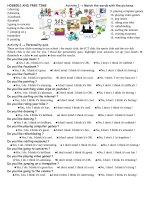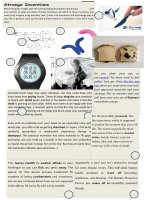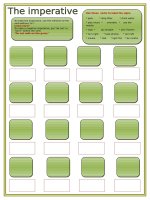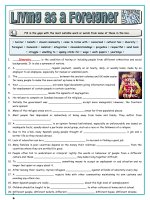islcollective worksheets intermediate b1 high school reading lesson plans fairy tales lesson plan 1340884874563311bf5c6f63 11416354
Bạn đang xem bản rút gọn của tài liệu. Xem và tải ngay bản đầy đủ của tài liệu tại đây (68.09 KB, 4 trang )
Fairy Tales
Introduction
Fairy Tales provide a wealth of possibilities for teaching English topics. Each fairy tale has its own magical setting and
is split into several scenes. Within each scene there are sets of vocabulary that you can exploit. Below we will look at
a few of the better known fairy tales and highlight some of the possible areas you can concentrate on in class.
Aims:
For the learners to hear in English what are probably familiar stories in their own language.
To allow the children to see English in an imaginative context.
To introduce various vocabulary sets such as family, food, clothes, parts of the body…
To help the older primary school children notice language areas such as past simple, comparatives, etc.
Material:
Fairy tale story books
Worksheets for post-reading activities
Flashcards (laminated photocopies of selected scenes from the stories.)
Five hot tips when using a fairy tale in class
1. Create a mystical atmosphere with your body language, voice and lighting if possible.
2. Don’t overdo the scary characters with the very young learners.
3. Involve the children as much as possible. Get them guessing the next episode throughout the story.
4. You don’t need to systematically pre-teach vocabulary. Arouse their interest? YES - with the picture on the front
cover, “Who’s this?” “Is this the wicked witch or the friendly fairy?” “Does the princess look sad or happy?” etc. You
can go back over vocabulary after the story e.g. “Can you remember what this is called?” (Pointing to the picture)
5. Don’t use it just as a time filler. The children will get much more out of it if done over a series of lessons or if it ties
in with a larger topic.
Something to remember about fairy tales is that they are fairly long stories and they don’t always have the repetitive
language that is almost essential for teaching English to young learners. The key here is to spend a little time
simplifying the story text and making it into a series of repeated patterns of language.
Cinderella
Vocabulary groups include:
Family (sisters, step-mother, father, god-mother)
Clothes (glass slippers, dress)
Adjectives (big, small, ugly, beautiful)
Telling the time (midnight, early, late)
Sample repetitive text:
“She tried on the slipper but it was too big.”
“She tried on the slipper but it was too small.”
“She tried on the slipper and it was just right.”
“She waved her magic wand and puff turned the pumpkin into a carriage.”
“She waved her magic wand and puff turned the rags into a beautiful dress.”
Possible language areas:
Past simple (tried on, waved, and turned) *remember to let the children notice the difference. You don’t need to
give them a lecture on the different uses, and forms of the past tense!
Snow White
Vocabulary groups include:
Adjectives (shy, happy, grumpy, and mean)
Landscapes (forest, lakes)
Buildings (houses, castles, towers)
Houses/furniture (beds, kitchens, housework)
Sample repetitive text:
“Mirror, mirror on the wall who is the prettiest of them all?”
Possible language areas:
Comparatives and superlatives – “You’re pretty, but Snow White is prettier. She’s the prettiest of them all.”
Little Red Riding Hood
Vocabulary groups include:
Animals (in the forest, wolf)
Food (apples, cakes)
Landscape (trees, lakes, forest)
Senses (hear, see, touch)
Parts of the body (ears, eyes, nose, hands, teeth)
Sample repetitive text:
“What big eyes you have!”
“They help me to see you better.”
Possible language areas:
“What have you got in your basket?”
“I’ve got two apples.”
Hansel and Gretel
Vocabulary groups include:
Family (father, step-mother)
Food (sugar, cakes, sweets)
Home/furniture (door, window, bed, oven)
Numbers (crumbs on the ground)
Sample repetitive text:
“He dropped a crumb on the ground, and another and another.”
“He dropped a pebble on the ground, and another and another.”
Post-reading activities
1. Draw a picture of your favourite character
2. Act out a scene from the story
3. Re-write the end of the story (this can be done on paper or orally)
4. Make up a group or class fairy tale. Use different characters from several fairy tales.
5. Point to flashcards of scenes from the story to identify characters or events.
6. Gradually uncover a flashcard from the story. The children have to say what they see.
Links
This site has some condensed fairy tales to be further simplified. Some can be listened to online.
/>
Fairy Tale web site links
/>
This site has a sample of activities to accompany Cinderella
/>
This site has a sample of activities for Snow White. (for upper primary)
/>
This site has several free sample pages from OUP for various fairy tales
/>
Lots of animated stories with sound to be enjoyed online.
/>









